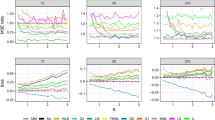Abstract
Cumulative sum (CUSUM) procedures have been used by many practitioners as an alternative to a Shewhart chart. The value of normality-based CUSUM procedures is well-established and CUSUM procedures have been used for decades. In recent years CUSUM procedures have also been proposed for random variables with non-normal distributions (see, e.g., Lucas [16, 17], Wang [32], Gan [8, 9], Radaelli [26], Mathers, Harris, and Lancaster [21], and Edgeman [6]
Access this chapter
Tax calculation will be finalised at checkout
Purchases are for personal use only
Preview
Unable to display preview. Download preview PDF.
Similar content being viewed by others
References
Amin, R.W., M. R. Reynolds, Jr., and S. Bakir (1995) Nonparametric control charts based upon the sign statistic. Communications in Statistics - Theory and Methods 24 1597–1623
Box, G. E. P. and A. Luceño (1997) Statistical Control by Monitoring and Feedback Adjustment. New York: Wiley
Brook, D. and D. A. Evans (1972) An approach to the probability distribution of CUSUM run length. Biometrika 59(3), 539–549
Champ, C. W. and S. E. Rigdon (1991) A comparison of the Markov chain and the integral equation approaches for evaluating the run length distribution of quality control charts. Communications in Statistics — Simulation and Computation 20(1), 191–204
Desmond, A. F. and G. R. Chapman (1993) Modeling task completion data with inverse Gaussian mixtures.Applied Statistics 42(4), 603–613
Edgeman, R. L. (1996) SPRT and CUSUM results for inverse Gaussian processes. Communications in Statistics — Theory and Methods 25(11), 2797–2806
Faddy, B. J. (1996) The Effect of Non-Normality on the Performance of Cumulative Sum Quality Control Schemes. Honours Thesis, Department of Statistics, University of Newcastle, Australia
Gan, F. F. (1993) An optimal design of CUSUM control charts for binomial counts. Journal of Applied Statistics 20, 445–460
Gan, F. F. (1994) Design of optimal exponential CUSUM control charts. Journal of Quality Technology 26 109–124
Geary, R.C. (1942) Testing for normality. Biometrika 34 209–242
Hawkins, D. M. (1993) Robustification of cumulative sum charts by Winsorization. Journal of Quality Technology 25, 248–261
Hawkins, D. M. and D. H. Olwell (1997) Inverse Gaussian cumulative sum control charts for location and shape. The Statistician 46(2), 323–335
Hawkins, D. M. and D. H. Olwell (1998) Cumulative Sum Charts and Charting for Quality Improvement. New York: Springer-Verlag
Kemp, K. W. (1967) An example of errors incurred by erroneously assuming normality for Cusum schemes. Technometrics 9 457–464
Lucas, J. M. (1982) Combined Shewhart-CUSUM quality control schemes. Journal of Quality Technology 8(1) 1–12
Lucas, J. M. (1985) Counted data CUSUMs. Technometrics 27 129–144
Lucas, J. M. (1989) Control schemes for low count levels. Journal of Quality Technology 21199–201
Lucas, J. M. and R. B. Crosier (1982a) Fast Initial Response for CUSUM quality control schemes: Give your CUSUM a head start. Technometrics 24(3), 199–205
Lucas, J. M. and R. B. Crosier (1982b) Robust CUSUM. Communications in Statistics — Theory and Methods 11 2669–2687
Lucas, J. M. and M. S. Saccucci (1990) Exponentially weighted moving average control schemes: properties and enhancements (with discussion). Technometrics 32 1–29
Mathers, C. D., R. S. Harris, and P. A. L. Lancaster (1994) A cusum scheme based on the exponential distribution for surveillance of rare congenital malformations. Australian Journal of Statistics 36 21–30
Montgomery, D. C. (1996) Introduction to Statistical Quality Control, 3rd edition. New York: Wiley
Moore, P. G. (1957) Normality in quality control charts. Applied Statistics 6(3), 171–179
Nester, M. (1996) An applied statistician’s creed. Applied Statistics 45(4), 401–410
Quesenberry, C. P. (1993) The effect of sample size on estimated limits for X and X control charts. Journal of Quality Technology 25(4), 237–247
Radaelli, G. (1994) Poisson and negative binomial dynamics for counted data under CUSUM-type charts. Journal of Applied Statistics 21, 347–356
Ryan, T. P. (1989)Statistical Methods for Quality Improvement. New York: Wiley
Ryan, T. P. (1997) “Individual contribution” to: A discussion of statistically-based process monitoring and control. Journal of Quality Technology 29 150–151
Schilling, E. G. and P. R. Nelson (1976) The effect of non-normality on the control limits of X-charts. Journal of Quality Technology 8(4), 183–188
Tweedie, M. C. K. (1957) Statistical properties of inverse Gaussian distributions, I. Annals of Mathematical Statistics [28 362–377
Van Dobben de Bruyn, C.S. (1968) Cumulative Sum Tests: Theory and Practice. Griffin’s Statistical Monographs and Courses No. 24. New York: Hafner
Wang, A.-L. (1990) Exponential cusum scheme for detecting a decrease in mean. Sankhya, Series B 52 105–114
Wheeler, D. J. and D. S. Chambers (1986)Understanding Statistical Process Control. Knoxville, TN: SPC Press
Woodall, W. H. (1984) On the Markov chain approach to the two-sided CUSUM procedure. Technometrics 26(1), 41–46
Yourstone, S. A. and W. J. Zimmer (1992) Non-normality and the design of control charts for averages. Decision Sciences 23 1099–1113
Author information
Authors and Affiliations
Editor information
Editors and Affiliations
Rights and permissions
Copyright information
© 2001 Springer-Verlag Berlin Heidelberg
About this paper
Cite this paper
Ryan, T.P., Faddy, B.J. (2001). The Effect of Non-Normality on the Performance of CUSUM Procedures. In: Lenz, HJ., Wilrich, PT. (eds) Frontiers in Statistical Quality Control 6. Frontiers in Statistical Quality Control, vol 6. Physica, Heidelberg. https://doi.org/10.1007/978-3-642-57590-7_11
Download citation
DOI: https://doi.org/10.1007/978-3-642-57590-7_11
Publisher Name: Physica, Heidelberg
Print ISBN: 978-3-7908-1374-6
Online ISBN: 978-3-642-57590-7
eBook Packages: Springer Book Archive




